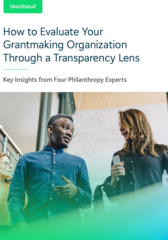Trust-Based Philanthropy: “Walking the Talk” Towards Long-Term Financial Wellness

We’ve recently witnessed an unprecedented number of what many consider to be “transformational gifts” across the social sector. Contributions range from tens of thousands to hundreds of millions of dollars—depending on the size of the recipient organization—while spanning a broad range of institutions and issue areas.
Take philanthropist MacKenzie Scott, whose donations have yielded more than $14 billion in funding for about 1,600 nonprofits since 2019, according to her long-awaited website Yield Giving. Then there’s Silicon Valley’s Teegan and Brian Acton. The couple funneled part of their windfall from selling WhatsApp into a $1 billion charitable entity, Wildcard Giving, with annual grantmaking targets approaching $50 million.
The common thread? The momentous impact the gift will have on the trajectory and pace of the organization and its work. Funders providing these types of gifts have a responsibility to trust their grantees to do what’s best for the organization while also supporting them with financial literacy.
The Role of Trust-Based Philanthropy
The growing interest in giving larger, unrestricted—and in many cases multi-year— commitments reflects a widening embrace of “trust-based philanthropy” (TBP) among select funders. At its core, TBP is rooted in a set of values and practices that help advance equity, shift dynamics, and build mutually accountable relationships across funders and practitioners.
The Trust Based Philanthropy Project is a five-year funder initiative that addresses inherent power imbalances between foundations and nonprofits. The movement espouses six key practices of TB grantmaking:
- Give Multi-Year, Unrestricted Funding: The work of nonprofits is long-term and unpredictable. Multi-year, unrestricted funding gives grantees the flexibility to assess and determine where grant dollars are most needed, and allows for innovation, emergent action, and sustainability.
- Do the Homework: Oftentimes, nonprofits have to jump through countless hoops just to be invited to submit a proposal. Trust-based philanthropy moves the onus to grantmakers, making it the funder’s responsibility to get to know prospective grantees, saving nonprofits time in the early stages of the vetting process.
- Simplify and Streamline Paperwork: Nonprofits spend an inordinate amount of time on funder-driven applications and reports, which can distract them from their mission-critical work. Streamlined approaches focused on dialogue and learning can pave the way for deeper relationships and mutual accountability.
- Be Transparent and Responsive: Open, honest, and transparent communication supports relationships rooted in trust and mutual accountability. When funders model vulnerability and power-consciousness, it signals to grantees that they can show up more fully.
- Solicit and Act on Feedback: Philanthropy doesn’t have all the answers. Grantees and communities provide valuable perspectives that can inform a funder’s strategy and approach, inherently making our work more successful in the long run.
- Offer Support Beyond the Check: Responsive, adaptive, non-monetary support bolsters leadership, capacity, and organizational health. This is especially critical for organizations that have historically gone without the same access to networks or level of support than their more established peers.
Ultimately, I see TBP as a catalyst to support the sustainable financial health and independence of nonprofit organizations over time. Indeed, promoting financial health and independence is a key step toward reducing power imbalances and enhancing equity—true transformation. Yet this will only happen if funders effectively “offer support beyond the check.” That means helping organizations position themselves as fiduciaries, with the requisite infrastructure, systems and skill sets to optimize unprecedented inflows of capital.
Helping Nonprofits Develop an Opportunity Mindset
The rationale for many “transformational gifts” has been to help nonprofits shift their mindset from scarcity to abundance. With scarcity, practitioners feel mired in current challenges and worried about how to fund the current year’s budget, leaving little room for “innovation” or pursuing long term solutions over short term fixes. It’s based in fear.
The abundance perspective, on the other hand, makes a commitment to invest in both near-term actions and long-term solutions. It prioritizes new ways of approaching problems or issues—along with the financial health, stability, and sustainability of the organization. Put simply, it’s an opportunity mindset.
When an organization wired for scarcity receives an unexpected and potentially game-changing gift, it’s like the “Sudden Wealth Syndrome” we see in personal finance. The overwhelming pressures that accompany unexpected and/or abrupt fortune can create emotional and behavioral afflictions. Symptoms include isolation and paranoia, guilt, shock, and uncertainty. It can also lead to paralysis and stifle decision-making. Boards and executive teams of nonprofit organizations may experience these same feelings—especially if they lack frameworks for effective fiduciary stewardship of both current funds and long-term investments.
Interestingly, recommended solutions point to increasing financial literacy. This often includes engaging trusted advisors to help assess the situation, provide unbiased advice, and help set realistic goals and objectives.
So, how can funders assist here?
Encouraging Grantmakers to Walk the Talk
Funders’ practices form a key component of TBP. What you do and how you show up as a grant maker matters. After all, we shouldn’t demand of nonprofit organizations fiduciary best practices that we don’t employ ourselves.
Gaps often exist when it comes to subject matter expertise as well as in the networks available to organizations. We often see this when determining how to build and implement fiduciary frameworks that support a long-term financial investment strategy. The first question my team and I typically hear is, “How exactly do we do this?” How can funders tap into their own networks and resources to help bridge this gap? What resources are out there, and what steps might we encourage organizations to take to support fiduciary effectiveness without becoming overly prescriptive?
I’d argue that funders should gain a basic understanding of—and model—the same fiduciary best practices organizations need to seize the opportunity to transition from scarcity to abundance. Specifically, this includes:
- Recruiting and building a finance and investment committee
- Strategically segmenting funds by purpose/time horizon
- Creating and maintaining both an investment policy and a spending policy
- Selecting a fiduciary partner and implementing on a consistent calendar
- Monitoring and onboarding new members over time
With the right team onboard—one well versed in and passionate about positioning financial capital for positive change—the possibilities are limitless. And we’ve only just begun.
Creating Long-Term Financial Wellness for Your Grantees
Your grantees understand the needs of their communities, but providing unrestricted, multi-year support can be a different way of thinking for many nonprofit organizations. You want the additional funding flexibility to be beneficial, not a burden.
Whether you are already incorporating the principles of trust-based philanthropy into your grantmaking or are looking for ways to get started, join us for a webinar where we discuss the steps you can take to help your practitioners achieve long-term financial success through trust-based philanthropy.
 Free Resource
Free Resource
Build Stronger Relationships
Evaluate your organization through a transparency lense with our free whitepaper

